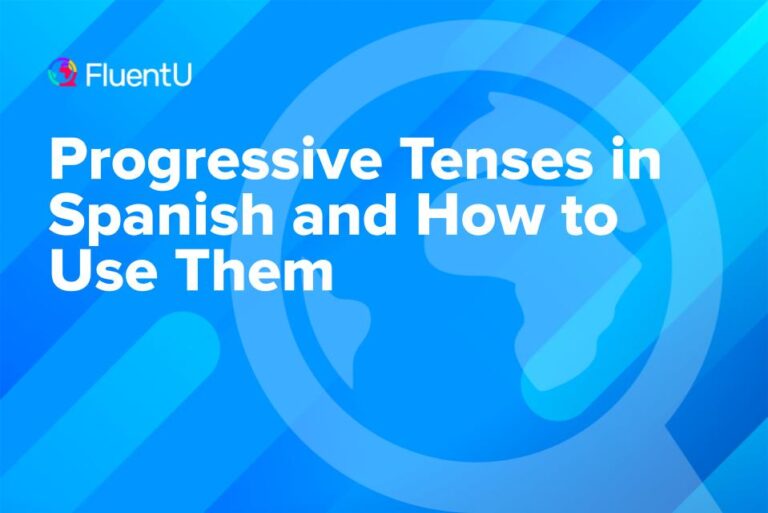Common False Cognates in Spanish
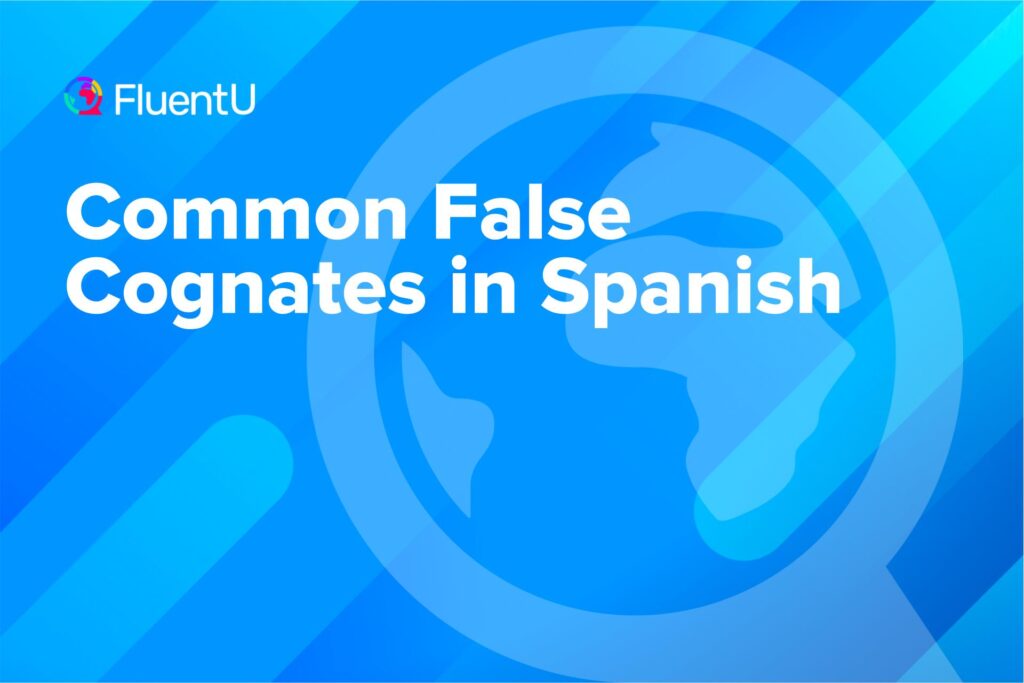
A cognate is a word that is spelled similarly and has the same meaning across two different languages. For instance, the English word “sofa” is el sofá in Spanish. But sometimes, a word only looks the same in both languages, but the two words actually have completely different meanings. These are what we call false cognates.
And learning about Spanish false cognates can save you from making huge Spanish slip-ups. We’ll teach you about 20 commonly mixed-up false cognates in Spanish so you can avoid some embarrassing misunderstandings.
Download: This blog post is available as a convenient and portable PDF that you can take anywhere. Click here to get a copy. (Download)
1. Actual
What it looks like: Actual
What it means: Current
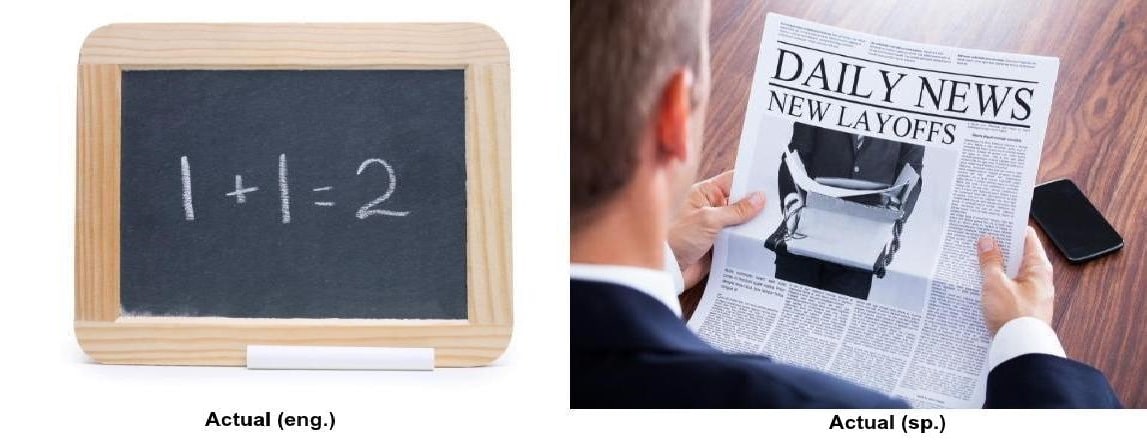
Actual in Spanish means “current” as in eventos actuales, or “current events.”
If you want the Spanish equivalent of the English “actual,” use the word real.
“Actually” would translate to en realidad, which is a quite common expression.
Example:
El presidente actual de ese país es muy popular.
(The current president of that country is very popular.)
2. Asistir
What it looks like: To assist
What it means: To attend
This one has the potential to set your head spinning. Asistir means “to attend” as you would do a meeting or lecture.
The word for “to help” is ayudar, and the noun “help” is ayuda. Always a good one to keep in mind.
Note: Asistir can sometimes be used to mean “to help,” but that meaning has mostly fallen out of use.
Example:
Asistí a todas mis clases la semana pasada.
(I attended all of my classes last week.)
3. Chocar
What it looks like: Choke
What it means: To collide; to clash

Chocar is what happens when two cars run into each other or two people get into a disagreement. It means “to collide” or “to clash,” not “to choke.”
In Spanish, “to choke” is ahogarse, assuming you’re talking about choking on food or drowning. Estrangular is when a person chokes another person.
Example:
Los autos chocaron afuera en el estacionamiento.
(The cars collided outside in the parking lot.)
4. Constipación
What it looks like: Constipation
What it means: A cold
Be sure you get this one right before calling in sick to work; otherwise, you might accidentally be giving your co-workers a bit too much information.
If you are actually constipated, the word for constipation is estreñimiento, but you might still want to keep that to yourself.
Example:
Está estornudando y tosiendo. Tiene síntomas de constipación.
(She is sneezing and coughing. She has the symptoms of a cold.)
5. Contestar
What it looks like: To contest
What it means: To answer

This seemingly strange translation actually makes sense when you think about it.
In English, the word “contest” is used when you must answer an argument in court. So it’s easy to see how it could have some relation to the Spanish word contestar, which means “to answer” a question or a telephone.
However, in court, you would use the Spanish word impugnar to contest a verdict.
Example:
La estudiante contestó las preguntas del profesor.
(The student answered the professor’s questions.”)
6. Delito
What it looks like: Delight
What it means: Crime
Whatever you do, don’t say “es un delito conocerte.” That means “It’s a crime to meet you,” and probably won’t make you very many friends.
“Delight” translates to deleite, but when meeting someone it’s better to say, “es un placer conocerte.” Placer means “pleasure.”
Example:
Fue a la cárcel después de cometer delitos financieros.
(He went to jail after committing financial crimes.)
7. Embarazada
What it looks like: Embarrassed
What it means: Pregnant

Using the word embarazada incorrectly could leave you, well… embarrassed.
There are a few different ways of saying “embarrassed” in Spanish depending on the dialect, but what I usually go for is tener vergüenza. It literally means, “to have shame,” but it does the same job.
Example:
Ella está embarazada y necesita descansar más.
(She is pregnant and needs to rest more.)
8. Enviar
What it looks like: To envy
What it means: To send

Far from being one of the 7 deadly sins, enviar simply means “to send.” You can “enviar” a letter, a package, or an email, but you can’t “enviar” your friends (well, I guess you could, but you should punch holes in the box).
If someone has something you wish you had, you can tener celos (to have jealousy) or envidiar (to envy) them.
Example:
Puedo enviarte un mensaje cuando llegue a la oficina.
(I can send you a message when I get to the office.)
9. Éxito
What it looks like: Exit
What it means: Success

If you were to ask someone where you can find the éxito you might be in for a bit of a philosophical reply. Instead, look for the signs marked salida, and get on with your day.
To make things even more confusing, the word suceso in Spanish means “event” or “something that happens.”
Example:
Hoy anunciamos el éxito de nuestro último proyecto.
(Today we announce the success of our latest project.)
10. Fábrica
What it looks like: Fabric
What it means: Factory

As much as I’d like to wear a shirt that’s made of factories, I don’t think it sounds very practical.
Instead, just opt for one made of tela like everyone else, it’s probably much cooler and more environmentally friendly.
Example:
La fábrica hace juguetes de plástico.
(The factory makes plastic toys.)
11. Introducir
What it looks like: Introduce
What it means: Insert

Introductions can be awkward enough without accidentally telling your friends that you’d like to insert them into each other.
A correct introduction for your friends would be, “Quiero presentarte a mi amigo [Miguel].” No insertion necessary.
Note: While introducir is not used for describing introducing people to each other, it can be used in the cases when “introduce” is being used to mean something like “bring forward” or “add.”
For instance, introducir is acceptable if you’re talking about introducing a new topic or introducing some new legislation. This also applies for introducing someone to a hobby or introducing an animal to a new habitat.
Example:
Necesito introducir los platos en el lavavajillas.
(I need to put the dishes in the dishwasher.)
12. Largo
What it looks like: Large
What it means: Long

This is an easy one to mix up when you’re a beginner because the two meanings are so similar.
However, largo is only used to refer to length, whereas grande is used to refer to the overall size. So something could be both largo and grande, or just one or the other.
Example:
Mi pelo era muy largo antes de cortarlo.
(My hair was very long before I cut it.)
13. Molestar
What it looks like: Molest
What it means: To annoy

This one does take a while to get used to actually saying out loud, but it’s important to know. You don’t want to get the wrong impression from someone complaining that their boss “molested” them all day in the office.
You might want to know that the true translation of “molest” is abusar (sexualmente).
Example:
El gatito siempre molesta a los gatos adultos.
(The kitten always bothers the adult cats.)
14. Pie
What it looks like: Pie
What it means: Foot
Even though the two are spelled the same, there is a difference in pronunciation. In Spanish, pie is pronounced “pee-eh” and means “foot.”
Two feet are dos pies, pronounced, “pee-ehs.” Something I always found funny is that the translation for “toes” is dedos del pie. Literally, “fingers of the foot.”
If you want an actual pie, you should order un pastel.
There are regions where you may also hear el pay to mean “pie”. This is pronounced the same as “pie” in English. Keep this in mind while exploring delicious Hispanic cuisine!
Example:
Me duele el pie de caminar demasiado.
(My foot hurts from walking too much.)
15. Preservativo
What it looks like: Preservative
What it means: Condom

What we call preservatives in English are called conservantes in Spanish. The word preservativo refers to condoms.
You can also say condón, but just don’t say that they’re in your food or your roommates might tease you for an entire semester.
Example:
Él compró preservativos antes de su cita.
(He bought condoms before his date.)
16. Rapista
What it looks like: Rapist
What it means: Barber; shaver

This actually isn’t a very common word, but still good to know. Rapista doesn’t mean “rapist” but actually means “barber” or more precisely, “a shaver” from the word rapar meaning “to shave” or “to crop.”
However, a more common word for “barber” is barbero or peluquero. The word for “rapist” is violador.
Example:
Va al rapista una vez al mes para un corte de pelo.
(He goes to a barber once a month for a haircut.)
17. Realizar
What it looks like: Realize
What it means: To do; to perform

Realizar means “to do” or “to perform.” For instance, “You realized your plan to take over the world.” It’s kind of like the word “execute” in English.
If you wanted to say that you “realized” something in a mental sense (as in, you noticed it or came to understand it), you would say “Me di cuenta…”
Example:
El doctor va a realizar una cirugía.
(The doctor is going to perform a surgery.)
18. Recordar
What it looks like: Record
What it means: To remember; to remind
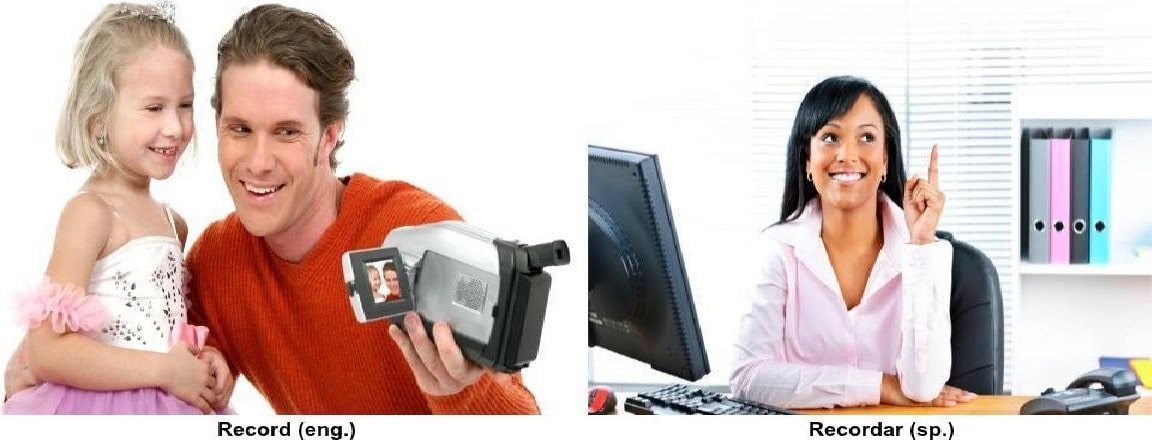
To remember something or to remind someone is recordar.
Hint: Grabar means “to record.”
Example:
Recuérdame mañana que necesito grabar el nuevo capítulo de Juego de Tronos.
(Remind me tomorrow that I need to record the new episode of Game of Thrones.)
19. Ropa
What it looks like: Rope
What it means: Clothes
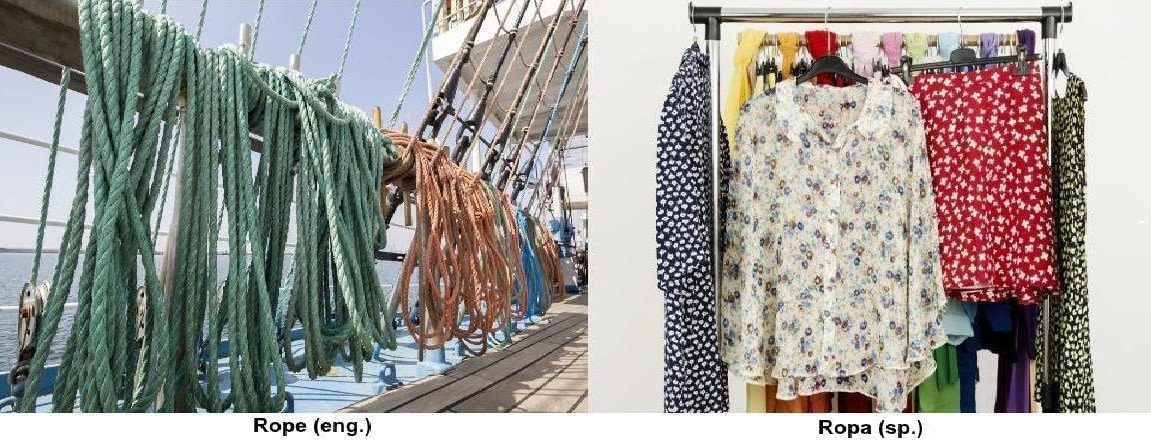
Ropa actually shares a root with the English word “robe,” so it’s easier to remember.
Just don’t make the mistake of thinking that Cuban ropa vieja is actually made of old clothes. It’s actually a very tasty dish of shredded beef, usually served with rice.
Actual “rope” is called cuerda or soga in Spanish.
Example:
Mi hija necesita ropa nueva para la escuela.
(My daughter needs new clothes for school.)
20. Sopa
What it looks like: Soap
What it means: Soup
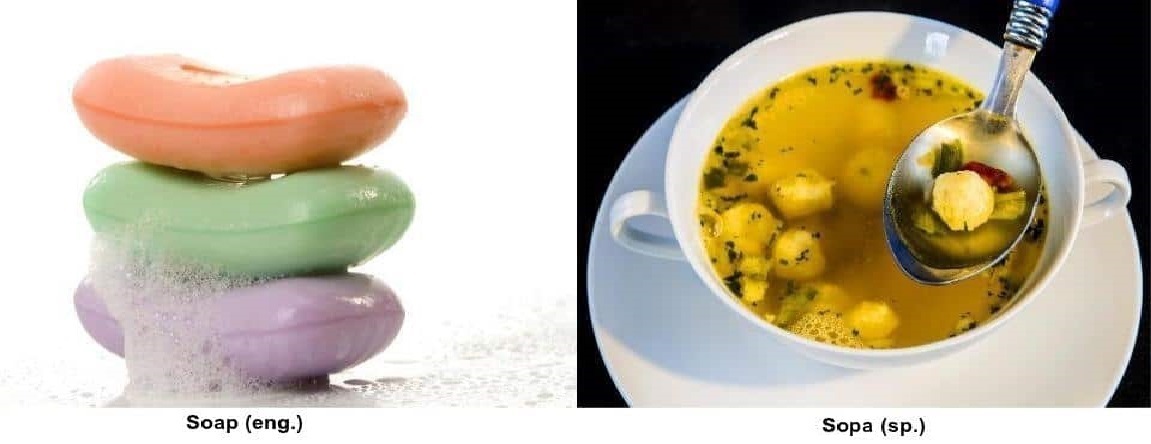
Maintaining a healthy lifestyle is important, and many people are making an effort to clean up their eating habits, but ordering soap in a restaurant might be taking it a bit too far.
If you need soap, the word is jabón, not to be confused with jamón, which is “ham” and perfectly fine to order.
Example:
¿El restaurante tiene sopa de albóndigas?
(Does the restaurant have meatball soup?)
If you can remember these 20 false Spanish cognates, you’ll be able to avoid quite a few mix-ups.
For practice, try watching authentic Spanish content such as news clips and YouTube videos to see if you can pick out any of these false cognates in real conversations.
For a learner-friendly approach, you can use the authentic video library on the language learning program FluentU.
FluentU takes authentic videos—like music videos, movie trailers, news and inspiring talks—and turns them into personalized language learning lessons.
You can try FluentU for free for 2 weeks. Check out the website or download the iOS app or Android app.
P.S. Click here to take advantage of our current sale! (Expires at the end of this month)

Each video includes interactive subtitles that let you see translations and usage information, helping you spot false cognates in context.
The sooner you learn these false cognates, the sooner you can save yourself from embarrassing slip-ups. Then again, they could make for some good laughs!
Download: This blog post is available as a convenient and portable PDF that you can take anywhere. Click here to get a copy. (Download)
And One More Thing…
If you've made it this far that means you probably enjoy learning Spanish with engaging material and will then love FluentU.
Other sites use scripted content. FluentU uses a natural approach that helps you ease into the Spanish language and culture over time. You’ll learn Spanish as it’s actually spoken by real people.
FluentU has a wide variety of videos, as you can see here:

FluentU brings native videos within reach with interactive transcripts. You can tap on any word to look it up instantly. Every definition has examples that have been written to help you understand how the word is used. If you see an interesting word you don’t know, you can add it to a vocab list.

Review a complete interactive transcript under the Dialogue tab, and find words and phrases listed under Vocab.

Learn all the vocabulary in any video with FluentU’s robust learning engine. Swipe left or right to see more examples of the word you’re on.

The best part is that FluentU keeps track of the vocabulary that you’re learning, and gives you extra practice with difficult words. It'll even remind you when it’s time to review what you’ve learned. Every learner has a truly personalized experience, even if they’re learning with the same video.
Start using the FluentU website on your computer or tablet or, better yet, download the FluentU app from the iTunes or Google Play store. Click here to take advantage of our current sale! (Expires at the end of this month.)
